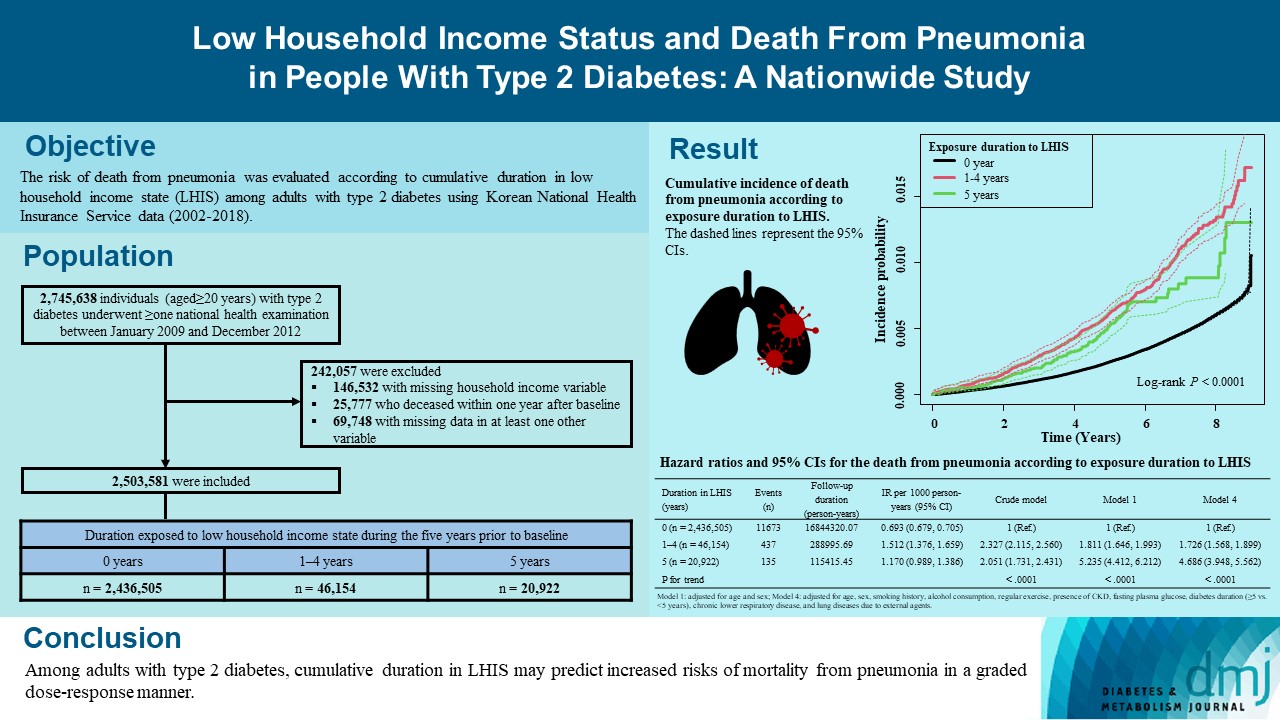
- Current
- Browse
- Collections
-
For contributors
- For Authors
- Instructions to authors
- Article processing charge
- e-submission
- For Reviewers
- Instructions for reviewers
- How to become a reviewer
- Best reviewers
- For Readers
- Readership
- Subscription
- Permission guidelines
- About
- Editorial policy
Search
- Page Path
- HOME > Search
Original Article
- Metabolic Risk/Epidemiology
- Low Household Income Status and Death from Pneumonia in People with Type 2 Diabetes Mellitus: A Nationwide Study
- You-Bin Lee, So Hee Park, Kyu-na Lee, Bongsung Kim, So Yoon Kwon, Jiyun Park, Gyuri Kim, Sang-Man Jin, Kyu Yeon Hur, Kyungdo Han, Jae Hyeon Kim
- Diabetes Metab J. 2023;47(5):682-692. Published online June 22, 2023
- DOI: https://doi.org/10.4093/dmj.2022.0184

- 1,645 View
- 122 Download
-
 Abstract
Abstract
 PDF
PDF Supplementary Material
Supplementary Material PubReader
PubReader  ePub
ePub - Background
We explored the risk of death from pneumonia according to cumulative duration in low household income state (LHIS) among adults with type 2 diabetes mellitus (T2DM).
Methods
Using Korean National Health Insurance Service data (2002 to 2018), the hazards of mortality from pneumonia were analyzed according to duration in LHIS (being registered to Medical Aid) during the 5 years before baseline (0, 1–4, and 5 years) among adults with T2DM who underwent health examinations between 2009 and 2012 (n=2,503,581). Hazards of outcomes were also compared in six groups categorized by insulin use and duration in LHIS.
Results
During a median 7.18 years, 12,245 deaths from pneumonia occurred. Individuals who had been exposed to LHIS had higher hazards of death from pneumonia in a dose-response manner (hazard ratio [HR], 1.726; 95% confidence interval [CI], 1.568 to 1.899 and HR, 4.686; 95% CI, 3.948 to 5.562 in those exposed for 1–4 and 5 years, respectively) compared to the non-exposed reference. Insulin users exposed for 5 years to LHIS exhibited the highest outcome hazard among six groups categorized by insulin use and duration in LHIS.
Conclusion
Among adults with T2DM, cumulative duration in LHIS may predict increased risks of mortality from pneumonia in a graded dose-response manner. Insulin users with the longest duration in LHIS might be the group most vulnerable to death from pneumonia among adults with T2DM.
Randomized Controlled Trial
- Relationship between Carotid Atherosclerosis and Chlamydia Pneumoniae Seropositivity in Type 2 Diabetes.
- Su Jin Jung, Ji Hye Kim, Ji Hyun Park, Tae Sun Park, Hong Sun Baek
- Korean Diabetes J. 2005;29(4):352-357. Published online July 1, 2005
- 1,174 View
- 16 Download
-
 Abstract
Abstract
 PDF
PDF - BACKGROUND
The major causes of death in diabetic patients are atherosclerosis-related diseases. Infection with Chlamydia pneumoniae(C. pneumoniae) has been reported to play a pathogenic role in atherosclerosis. However, data relating to C. pneumoniae exposure are rare in type 2 diabetes that are more susceptible to infection. The aim of this study was to see whether C. pneumoniae seropositivity was associated with carotid atherosclerosis in type 2 diabetic patients. METHODS: The subjects of this study were 135 type 2 diabetic patients. Serum samples from the subjects were assayed for risk factors, including lipid profiles, HbA1c, fibrinogen and CRP. Serum titers of antibodies to C. pneumoniae(IgG, IgM) were measured using microimmunofluorescence(MIF). tests Carotid ultrasound examination was used to measure the intima-media thickness(IMT), plaques and the presence of stenosis in each segment of both carotid arteries. RESULTS: C. pneumoniae seropositivity was detected in 17.8%(n=24), but without any difference between the sexes, in the 135 type 2 diabetic patients. The CRP level was increased in the seropositive group(P=0.041). The presence of carotid stenosis and IMT were significantly from a associated with C. pneumoniae seropositivity from a univariate analysis(IMTmean: IgG(+), 0.93mm vs. IgG(-), 0.85mm, P = 0.038, IMTmax: IgG(+), 1.29mm vs. IgG(-), 1.17mm, P = 0.025, stenosis: IgG (+), 25% vs. IgG(-) 7.2%, P = 0.020). No association was found for the plaque count or score. After controlling for cardiovascular risk factors, including age, sex, hypertension, cholesterol, and CRP, the association of C. pneumonia seropositivity with the IMTmean or carotid stenosis remained significant(IMTmean: P = 0.027, stenosis: P = 0.026). CONCLUSIONS: Serologic evidence of C. pneumoniae infection was detected in 17.8% randomly-assigned type 2 diabetic patients. C. pneumoniae seropositivity may be a risk factor for carotid atherosclerosis in type 2 diabetic patients.
Original Article
- Endogenous Streptococcus pneumoniae Endophthalmitis in Diabetic Patients.
- Jung Min Lee, Hyun Shik Son, Ki Ho Song, Kun Ho Yoon, Bong Yun Cha, Kwang Woo Lee, Ho Young Son, Sung Koo Kang
- Korean Diabetes J. 2002;26(6):520-524. Published online December 1, 2002
- 913 View
- 18 Download
-
 Abstract
Abstract
 PDF
PDF - Endogenous bacterial endophthalmitis is a rare disease, but has recently been been on the increase due to the increase of chronicity of disease, especially in immunocompromised hosts, and drug abusers, etc. In spite the aggressive topical and systemic management, endophthalmitis has poor prognosis. Therefore, early its diagnosis and appropriate treatment, mandatory for the improvement of the prognosis. We present a case of endogenous Streptococcus pneumoniae endophthalmitis, associated with bacteremia, but with no symptoms, with the exception of ocular pain, in a poorly controlled diabetic patient.

 KDA
KDA First
First Prev
Prev





